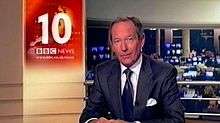BBC News at Ten
BBC News at Ten — formerly known as the BBC Ten O'Clock News or the Ten O'Clock News — is the flagship evening news programme for British television channel BBC One and the BBC News channel. It is presented by Huw Edwards Monday to Wednesday, and deputised by Sophie Raworth and Clive Myrie. The programme was controversially moved from 9:00pm on 16 October 2000. The main presenter simultaneously holds the lead presenter role for major events, election night (from 2015) and breaking news for BBC News.
| BBC News at Ten | |
|---|---|
 | |
| Also known as | BBC Ten O'Clock News |
| Created by | BBC News |
| Presented by | |
| Theme music composer | David Lowe |
| Country of origin | United Kingdom |
| Original language(s) | English |
| Production | |
| Production location(s) | Studio N6 BBC Television Centre (1986-2013) Studio E, Broadcasting House, London (2013-present) |
| Running time | 35 minutes |
| Release | |
| Original network | BBC One |
| Picture format | |
| Original release | 16 October 2000 – present |
| Chronology | |
| Preceded by | BBC Nine O'Clock News |
| Related shows | |
| External links | |
| Website | |
From 2015 to 2019, the programme featured a 45-minute format, with a half-hour segment focusing on British national and international news (with an emphasis on the latter), a 12-minute segment featuring local news from the BBC's regions around the country, and concluding with the national weather forecast. The programme used a shortened, 35-minute format on Friday nights to accommodate The Graham Norton Show. In February 2019, in order to accommodate a new time slot focusing on youth programmes from BBC Three, the shortened format was adopted on a nightly basis. The programme was re-extended during the 2019 general election and the 2019-20 COVID-19 pandemic.
During the first three months of its revival, ITV News at Ten averaged 2.2 million viewers compared with an average of 4.8 million viewers watching the BBC bulletin over the same period.[1]
History
The programme was launched on 16 October 2000, replacing the former BBC Nine O'Clock News, which had been on the air since 14 September 1970. Its launch presenters were Michael Buerk and Peter Sissons. The move to 10pm was a response to the controversial axing of rival broadcaster ITV's News at Ten. ITV reinstated a 20-minute news bulletin at 10pm in 22 January 2001, instigating a head-to-head clash with the BBC. The BBC's Ten O'Clock News eventually became the more popular programme, establishing itself on the BBC One schedule for at least six days a week. ITV's bulletin suffered as a result of poor scheduling, and on 2 February 2004 the bulletin moved to 10:30pm.[2] In 2008, ITV reinstated News at Ten which remains the BBC's main competitor.

Buerk and Sissons left the BBC Ten O'Clock News on 19 January 2003 to make way for presenters Huw Edwards and Fiona Bruce. To mark this presenter reshuffle, on Monday 20 January 2003 as Edwards and Bruce took over, the bulletin and the rest of BBC One news bulletins were relaunched with a new studio.
Since 5 February 2006, the bulletin has been simulcast on the BBC News channel. Following the BBC One bulletin, the remaining portion of the BBC Ten O'Clock News Hour is followed by Sports News and ‘The Papers’.
On 21 April 2008 the programme, along with the rest of BBC News, underwent a graphical refresh and moved into a refurbished studio (N6). It also changed its name to BBC News at Ten.
After the regional news, there is a weather forecast from the BBC Weather Centre: presenters include Rob McElwee, Peter Gibbs, John Hammond and Philip Avery.
BBC News at Ten was named News Programme of the Year at the RTS Television Journalism Awards in 2005, 2009 and 2010.
The programme, along with the BBC News channel and the other BBC One bulletins, moved to Broadcasting House and began broadcasting in high-definition on 18 March 2013.[3]
Following a five-month trial during the run-up to the 2015 general election, it was announced that the programme would be permanently extended to 45 minutes on Mondays through Thursdays from January 2016 (with the Friday-night edition retaining its original length to accommodate The Graham Norton Show).[4]
After 16 years in the role, in January 2019, Bruce stepped down as the programme's main presenter on Fridays in order to replace David Dimbleby on Question Time. Sophie Raworth and Clive Myrie serve as the regular presenters on Fridays with Bruce occasionally appearing on the programme as a relief presenter.
In February 2019, it was announced that the programme would be shortened back to 35 minutes beginning 4 March 2019, to accommodate a new broadcast of BBC Three programmes on Monday, Tuesday, and Wednesday nights. The decision faced criticism from those who believed this was the result of cuts. BBC staff denied that this was the case, arguing that the time slot could help attract BBC Three's target audience, and would also remove the scheduling overlap with Newsnight on BBC Two.[5][6]
In March 2020, in light of the COVID-19 pandemic, the programme was extended to a 45 minute bulletin until further notice.
Out-of-studio presenting
As well as presenting from the main studio, the main presenters are called upon to present on location when major stories break. For example, Huw Edwards reported live from Washington for the 2008, 2012 and 2016 US presidential elections and has presented live from Basra at the withdrawal ceremony. He also regularly presented from Westminster, as well as from Edinburgh (at times when the referendum for Scottish independence was being developed).
During the 2012 Summer Olympics, presenters also made use of BBC's makeshift studios overlooking the Olympic Park at Stratford. George Alagiah presented from L'Aquila in April 2009, Haiti in 2010, Egypt in 2011, and Tacloban in 2013.
Staff
Editor
Paul Royall has been the editor of BBC News at Ten and BBC News at Six since July 2013.[7] Royall joined the BBC from ITV Meridian in 1997, working on News 24. He later became Deputy Editor of BBC Breakfast in January 2004, to the Editor Mark Grannell.[8] In May 2009 he became the Deputy Editor of the News at Ten and News at Six. He became Editor on 22 July 2013, replacing James Stephenson who became Head of BBC World News.[7]
Presenters
| Years | Presenter | Current role |
|---|---|---|
| 2003–present | Huw Edwards | Main Presenter (Monday–Wednesday) |
| 2003–present | Sophie Raworth | Main Presenter (Thursday) and Relief Presenter |
| 2015–present | Clive Myrie | Main Presenter (Friday and alternate Sunday) and Relief Presenter |
| 2010–present | Mishal Husain | Main Presenter (alternate Sunday) |
| 2003-present | Fiona Bruce | Regular Relief Presenters |
| 2014–present | Reeta Chakrabarti | |
| 2014–present | Jane Hill | |
| 2018–present | Tina Daheley |
Former presenters
If there is no position before the years of being a presenter, then this newsreader was either a relief presenter or occasional guest presenter.
- Michael Buerk (Main presenter, 2000–2003)
- Peter Sissons (Main presenter, 2000–2003)
- George Alagiah (2000–2014)
- Darren Jordon (2003–2006)
- Dermot Murnaghan (2004–2007)
- Sian Williams (2004–2013)
- Natasha Kaplinsky (2006–2007)
- Jon Sopel (2006–2007)
- Chris Lowe (2006–2007)
- Ben Brown (2007 & 2018)
- Emily Maitlis (2007–2013)
- Simon McCoy (2019)
See also
References
- "BBC wins the News ratings battle". The Guardian. 17 April 2008.
- Fitzwalter, Raymond (1 January 2008). "The Dream That Died: The Rise and Fall of ITV". Troubador Publishing – via Google Books.
- "BBC News' television output moves to new studios at Broadcasting House". BBC. 18 March 2013. Retrieved 18 March 2013.
- "BBC News at Ten to extend by 10 minutes". BBC. 10 December 2015. Retrieved 11 December 2015.
- "BBC Three programming returns to linear TV". TVBEurope. 11 February 2019. Retrieved 3 October 2019.
- Waterson, Jim (14 February 2019). "Anger over BBC plan to cut News at Ten by 10 minutes". The Guardian. ISSN 0261-3077. Retrieved 3 October 2019.
- Article on appointment and background in Press Gazette
- BBC News article.